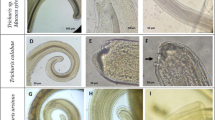Abstract
Trichuris sp. individuals were collected from Myocastor coypus from fancy breeder farms in the Czech Republic. Using morphological and biometrical methods, 30 female and 30 male nematodes were identified as Trichuris myocastoris. This paper presents the first molecular description of this species. The ribosomal DNA (rDNA) region, consisting of internal transcribed spacer (ITS)-1, 5.8 gene and ITS-2, was sequenced. Based on an analysis of 651 bp, T. myocastoris was found to be different from any other Trichuris species for which published sequencing of the ITS region is available. The phylogenetic relationships were estimated using the maximum parsimony methods and Bayesian analyses. T. myocastoris was found to be significantly closely related to Trichuris of rodents than those of ruminants.



Similar content being viewed by others
References
Babero BB, Lee JW (1961) Studies on the helminths of nutria, Myocastor coypus (Molina), in Louisiana with check list of other worm parasites from this host. J Parasitol 47:378–390
Baruš V, Majumdar G, Mikailov TK (1975) Morphology and taxonomy of Trichocephalus myocastoris (Enigk, 1933). Folia Parasitologica Praga 22:207–213
Callejón R, de Rojas M, Ariza C, Ubeda JM, Guevara DC, Cutillas C (2008) Cytochrome oxidase subunit 1 and mitochondrial 16S rDNA sequences of Trichuris skrjabini (Tricocephalida: Trichuridae). Parasitol Res 104:715–716
Cutillas C, Oliveros R, de Rojas M, Guevara DC (2004) Determination of Trichuris skrjabini by sequencing of the ITS1-5.8S-ITS2 segment of the ribosomal DNA: comparative molecular study of different species of Trichurids. J Parasitol 90(3):648–652
Dobrovol’skii AV (1952) Parazitarnye zabolevaniya u ondatry (Ondatra zibethica L.). Zoologicheskii Zhurnal 31(4):640–642
Enigk K (1933) Einige Nematoden aus der Nutria. Parasitol Res 6(3):326–331
Feliu C, Spakulova M, Casanova JC, Renaud F, Morand S, Hugot JP, Santalla F, Durand P (2000) Genetic and morphological heterogeneity in small rodent whipworms in southwestern Europe: characterization of Trichuris muris and description of Trichuris arvicolae n. sp (Nematoda: Trichuridae). J Parasitol 86(3):442–449
Gagarin VG (1972) Analiz vidogo sostava trihicefalov zvačnyh, zaregistrirovannyh v Sovetskom Spuze. Trudy Vsesojuznogo Instituta Gelmintologii K I Skrjabina 19:39–75
Gayo V, Cuervo P, Rosadilla D, Birriel S, Dell’Oca L, Trelles A, Cuire U, Sierra RMY (2011) Natural Fasciola hepatica infection in nutria (Myocastor coypus) in Uruguay. J Zoo Wildl Med 42(2):354–356
Hall TA (1999) BioEdit: a user-friendly biological sequence alignment editor and analysis program for Windows 95/98/NT. Nucleic Acids Symp Ser 41:95–98
Hohner L (1961) Die Endoparasiten des Sumpfebibers unter besonderer Berücksichtigung der Kokzidien. Zoologischen Institut und Veterinär–Parasitologischen Institut der Karl–Marx Universotät Leipzig. pp. 98–151
Huelsenbeck JP, Ronquist F (2001) MRBAYES: Bayesian inference of phylogenetic trees. Bioinformatics 17:754–755
Martino PE, Radman N, Parrado E, Bautista E, Cisterna C, Silvestrini MP, Corba S (2012) Note on the occurrence of parasites of the wild nutria (Myocastor coypus, Molina, 1782). Helminthologia 49(3):164–168
Oliveros R, Cutillas C, de Rojas M, Arias P (2000) Characterization of four species of Trichuris (Nematoda: Enoplida) by their second internal transcribed spacer ribosomal DNA sequence. Parasitol Res 86:1008–1013
Pastuszko J (1991) The examination of intestinal parasitofauna in coypu (Myocastor coypus, Molina 1782) from closed husbandries with particular regard to coccidia. Akademii Rolniczej we Wrocławiu. p. 41
Pellérdy LP (1963) Catalouge of Eimeriidea (Protozoa, Sporozoa). Akademiai Kiadó Budapest. p. 122
Pellérdy LP (1974) Coccidia and coccidiosis. Verlag Paul Parey, Berlin, p 959
Petrov AM (1941) Glistnye bolezni pushnykh zverey. Mosqow. pp. 1–227
Ribas A, Lopez S, Makundi RH, Leirs H, de Bellocq JG (2013) Trichuris spp. (Nematoda: Trichuridae) from two rodents, Mastomys natalensis and Gerbilliscus vicinus in Tanzania. J Parasitol 99(5):868–875
Robles MD, Navone GT, Notarnicola J (2006) A new species of Trichuris (Nematoda: Trichuridae) from Phyllotini rodents in Argentina. J Parasitol 92(1):100–104
Robles MD, Cutillas C, Panei CJ, Callejón R (2014) Morphological and molecular characterization of a new Trichuris species (Nematoda- Trichuridae), and phylogenetic relationships of Trichuris species of cricetid rodents from Argentina. PLoS One 11(9):1–11
Rossin MA, Varela G, Timi JT (2009) Strongyloides myopotami in ctenomyid rodents: transition from semi-aquatic to subterranean life cycle. Acta Parasitologica 54(3):257–262
Salaba O, Rylková K, Vadlejch J, Petrtýl M, Scháňková Š, Brožová A, Jankovská I, Jebavý L, Langrová I (2013) The first determination of Trichuris sp. from roe deer by amplification and sequenation of the ITS1-5.8S-ITS2 segment of ribosomal DNA. Parasitol Res 112(3):955–960
Torres EJL, Nascimento APF, Menezes AO, Garcia J, dos Santos MAJ, Maldonado A, Miranda K, Lanfredi RM, de Souza W (2011) A new species of Trichuris from Thrichomys apereoides (Rodentia: Echimyidae) in Brazil: morphological and histological studies. Vet Parasitol 176(2-3):226–235
Tůmová E, Chodová D, Hrstka Z (2013) Hodnocení masné užitkovosti nutrií. Certifikovaná metodika ČZU v Praze, p. 27
Woods CA, Contreras L, Willner-Chapman G, Whidden HP (1992) Myocastor coypus. Mamm Species 398:1–8
Zajíček D (1955) Parazitární invaze u mladých nutrií. Sborník Vysoké školy zemědělské a lesnické v Brně, řada B, Spisy fakulty veterinární 3–4(224):95–104
Zhu X, Gasser RB, Jacobs DE, Hung G-C, Chilton NB (2000) Relationships among some ascaridoid nematodes based on ribosomal DNA sequence data. Parasitol Res 86:738–744
Acknowledgments
This study has been funded by the Ministry of Agriculture of the Czech Republic (Nutria Genetic Resources Programme) and the Grant of National Agency for Agricultural Research of the Czech Republic, v.v.i. CIGA No. 20152021. We would also like to thank Mr. Brian Kavalir for his proofreading services.
Author information
Authors and Affiliations
Corresponding author
Rights and permissions
About this article
Cite this article
Rylková, K., Tůmová, E., Brožová, A. et al. Genetic and morphological characterization of Trichuris myocastoris found in Myocastor coypus in the Czech Republic. Parasitol Res 114, 3969–3975 (2015). https://doi.org/10.1007/s00436-015-4623-8
Received:
Accepted:
Published:
Issue Date:
DOI: https://doi.org/10.1007/s00436-015-4623-8




